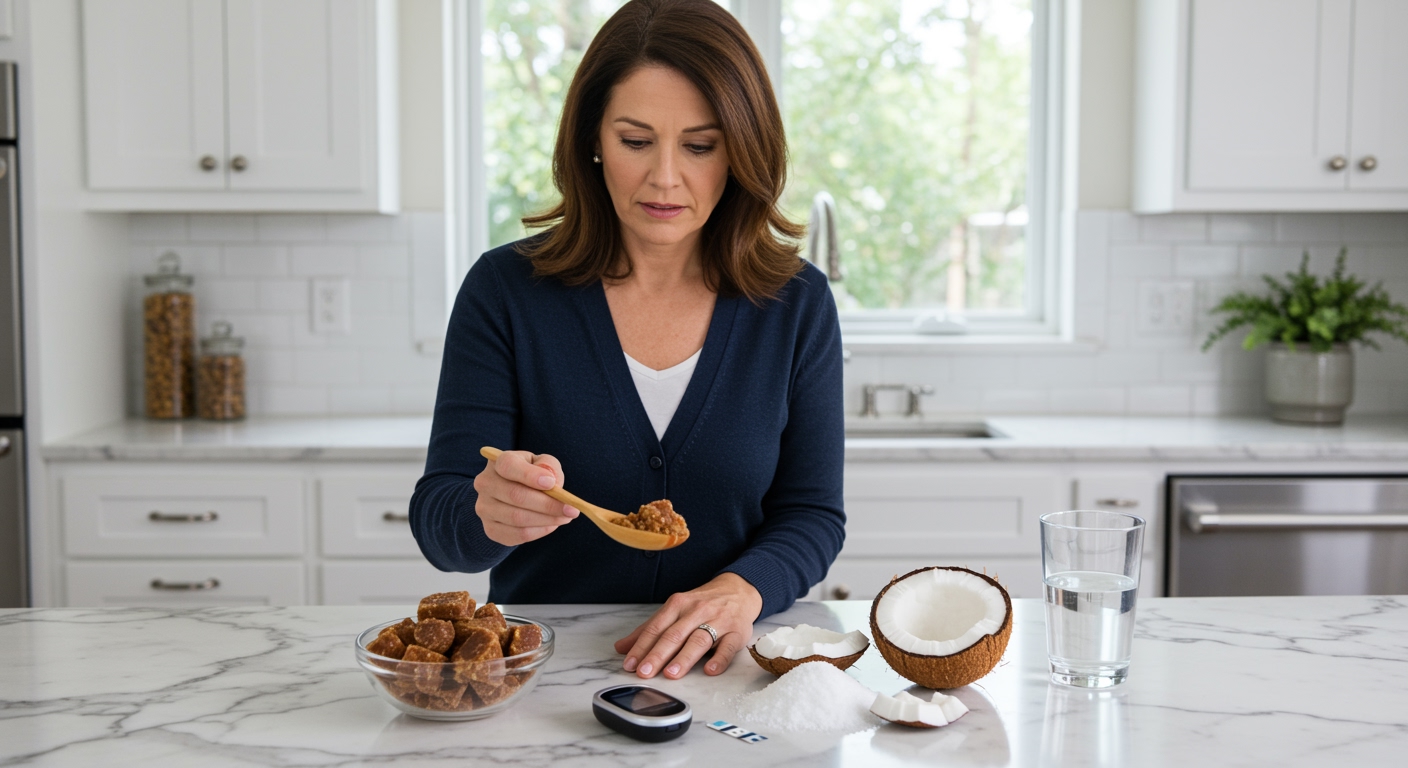✪ Key Takeaway: Palm sugar raises blood glucose similarly to regular sugar and is not safe for diabetes management.
Introduction
You walk down the health food aisle and see palm sugar marketed as a natural, healthier alternative to white sugar.
If you have diabetes, you might wonder whether this brown, granular sweetener could be the answer to your sugar cravings without the blood glucose spikes.
Hi, I am Abdur, your nutrition coach, and today I am going to explain whether palm sugar is truly safe for people with diabetes and what the science actually says about its effects on blood sugar.
What Exactly Is Palm Sugar?
Palm sugar comes from the sap of various palm trees, including coconut palms, date palms, and sugar palms.
The process involves collecting the sweet sap from palm flower buds and then boiling it down until the water evaporates, leaving behind crystallized sugar.
This traditional method has been used for centuries across Southeast Asia, India, and parts of Africa.
The final product appears as brown granules or blocks with a slightly caramel-like flavor that differs from refined white sugar.
Many people assume that because palm sugar undergoes less processing than white sugar, it must be healthier for blood glucose control.
However, the chemical composition tells a different story that people with diabetes need to understand.
✪ Fact: Palm sugar contains 70-80% sucrose, the same sugar molecule found in table sugar.
How Does Palm Sugar Affect Blood Glucose?
When you consume palm sugar, your digestive system breaks down its sucrose content into glucose and fructose molecules.
These simple sugars enter your bloodstream rapidly, causing your blood glucose levels to rise just like they would with regular table sugar.
Research shows that palm sugar has a glycemic index of approximately 54, which falls into the medium range but still causes significant blood sugar spikes.
For comparison, white sugar has a glycemic index of 65, making palm sugar only slightly better in terms of glucose response.
Your pancreas responds to palm sugar consumption by releasing insulin to help cells absorb the glucose from your bloodstream.
If you have diabetes, your body either cannot produce enough insulin or cannot use insulin effectively, making it difficult to manage the blood sugar elevation that palm sugar causes.
✪ Pro Tip: Test your blood glucose 2 hours after consuming palm sugar to see your individual response.
Does Palm Sugar Provide Any Nutritional Benefits?
Palm sugar contains small amounts of minerals like potassium, iron, and zinc that are absent in refined white sugar.
However, these mineral quantities are so minimal that you would need to consume large amounts of palm sugar to get any meaningful nutritional benefit.
For example, one tablespoon of palm sugar provides only about 2% of your daily potassium needs while delivering 12 grams of sugar.
The trace amounts of antioxidants found in palm sugar are negligible compared to what you can get from fruits, vegetables, and other whole foods.
Marketing claims about palm sugar being a superfood or significantly more nutritious than other sugars are misleading and not supported by scientific evidence.
When managing diabetes, the minimal nutritional benefits of palm sugar do not outweigh its negative impact on blood glucose control.
✪ Note: You can get more minerals from one banana than from several tablespoons of palm sugar.
What Are The Risks For People With Diabetes?
Using palm sugar when you have diabetes can lead to the same complications as consuming any other form of added sugar.
Regular consumption contributes to poor blood glucose control, making it harder to maintain your target HbA1c levels.
The caloric density of palm sugar is nearly identical to white sugar, with about 15 calories per teaspoon, which can contribute to weight gain if consumed regularly.
Weight management becomes more challenging when you include palm sugar in your diet, and excess weight makes diabetes management more difficult.
Palm sugar can also trigger the same sugar cravings and blood glucose rollercoaster that other sweeteners cause, making it harder to stick to a diabetes-friendly eating plan.
The false sense of security that comes from believing palm sugar is healthier might lead you to consume more of it, potentially causing greater harm to your glucose control.
✪ Pro Tip: Track your blood sugar patterns for one week after eliminating palm sugar to see the difference.
What Should You Use Instead?
Instead of palm sugar, focus on natural sweetness from whole foods like berries, which provide fiber and nutrients along with their natural sugars.
Stevia, monk fruit, and erythritol are better alternatives because they do not raise blood glucose levels significantly.
Cinnamon, vanilla extract, and other spices can add sweetness and flavor to foods without affecting your blood sugar.
If you must use a caloric sweetener occasionally, choose one that you can measure precisely and account for in your carbohydrate counting.
The key is developing your taste preferences away from intensely sweet foods rather than finding the perfect sugar substitute.
Over time, your taste buds will adapt to enjoy foods with less sweetness, making diabetes management much easier and more sustainable.
The Bottom Line
Palm sugar is not safe for diabetes management because it raises blood glucose levels similarly to regular sugar despite its natural origins and minimal processing.
Natural does not always mean healthy, especially when managing a condition that requires careful blood sugar control.
I would love to hear about your experiences with different sweeteners and how they affect your blood glucose levels, so please share your thoughts and questions in the comments below.
References
At NutritionCrown, we use quality and credible sources to ensure our content is accurate and trustworthy. Below are the sources referenced in creating this article:
- PMC: Glycemic index of palm sugar
- Medical News Today: Is palm sugar good for you
- PMC: Palm sugar and diabetes research
- Prodia Digital: Is palm sugar good for diabetes





